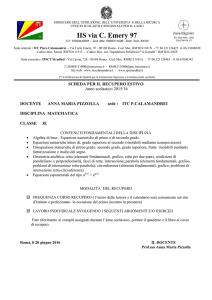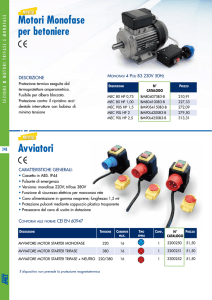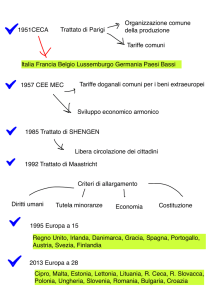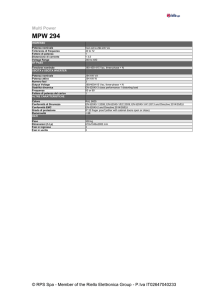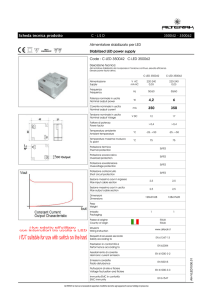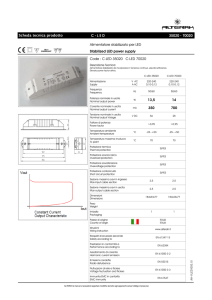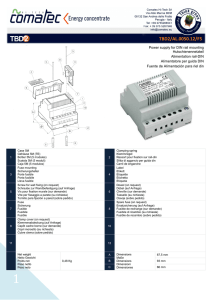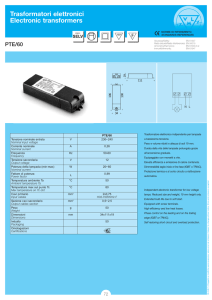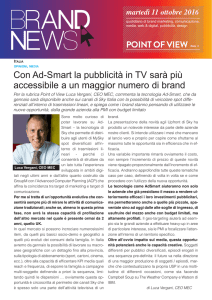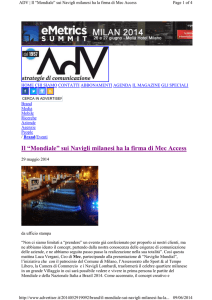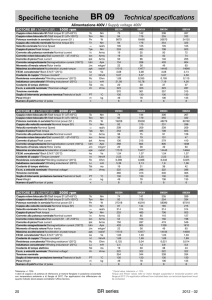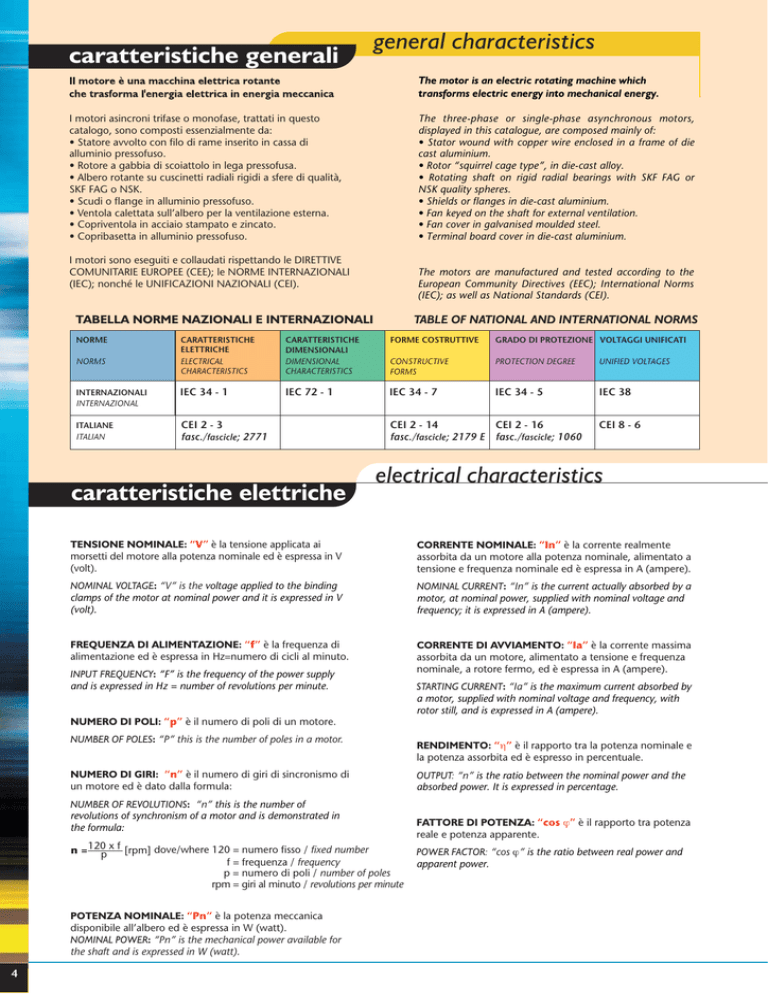
caratteristiche generali
general characteristics
The motor is an electric rotating machine which
transforms electric energy into mechanical energy.
I motori asincroni trifase o monofase, trattati in questo
catalogo, sono composti essenzialmente da:
• Statore avvolto con filo di rame inserito in cassa di
alluminio pressofuso.
• Rotore a gabbia di scoiattolo in lega pressofusa.
• Albero rotante su cuscinetti radiali rigidi a sfere di qualità,
SKF FAG o NSK.
• Scudi o flange in alluminio pressofuso.
• Ventola calettata sull’albero per la ventilazione esterna.
• Copriventola in acciaio stampato e zincato.
• Copribasetta in alluminio pressofuso.
The three-phase or single-phase asynchronous motors,
displayed in this catalogue, are composed mainly of:
• Stator wound with copper wire enclosed in a frame of die
cast aluminium.
• Rotor “squirrel cage type”, in die-cast alloy.
• Rotating shaft on rigid radial bearings with SKF FAG or
NSK quality spheres.
• Shields or flanges in die-cast aluminium.
• Fan keyed on the shaft for external ventilation.
• Fan cover in galvanised moulded steel.
• Terminal board cover in die-cast aluminium.
I motori sono eseguiti e collaudati rispettando le DIRETTIVE
COMUNITARIE EUROPEE (CEE); le NORME INTERNAZIONALI
(IEC); nonché le UNIFICAZIONI NAZIONALI (CEI).
The motors are manufactured and tested according to the
European Community Directives (EEC); International Norms
(IEC); as well as National Standards (CEI).
TABELLA NORME NAZIONALI E INTERNAZIONALI
TABLE OF NATIONAL AND INTERNATIONAL NORMS
CARATTERISTICHE
ELETTRICHE
ELECTRICAL
CHARACTERISTICS
CARATTERISTICHE
DIMENSIONALI
DIMENSIONAL
CHARACTERISTICS
FORME COSTRUTTIVE
GRADO DI PROTEZIONE VOLTAGGI UNIFICATI
CONSTRUCTIVE
FORMS
PROTECTION DEGREE
UNIFIED VOLTAGES
INTERNAZIONALI
INTERNAZIONAL
IEC 34 - 1
IEC 72 - 1
IEC 34 - 7
IEC 34 - 5
IEC 38
ITALIANE
ITALIAN
CEI 2 - 3
fasc./fascicle; 2771
NORME
NORMS
caratteristiche elettriche
CEI 2 - 14
CEI 2 - 16
fasc./fascicle; 2179 E fasc./fascicle; 1060
CEI 8 - 6
electrical characteristics
TENSIONE NOMINALE: “V” è la tensione applicata ai
morsetti del motore alla potenza nominale ed è espressa in V
(volt).
CORRENTE NOMINALE: “In” è la corrente realmente
assorbita da un motore alla potenza nominale, alimentato a
tensione e frequenza nominale ed è espressa in A (ampere).
NOMINAL VOLTAGE: “V” is the voltage applied to the binding
clamps of the motor at nominal power and it is expressed in V
(volt).
NOMINAL CURRENT: “In” is the current actually absorbed by a
motor, at nominal power, supplied with nominal voltage and
frequency; it is expressed in A (ampere).
FREQUENZA DI ALIMENTAZIONE: “f” è la frequenza di
alimentazione ed è espressa in Hz=numero di cicli al minuto.
CORRENTE DI AVVIAMENTO: “Ia” è la corrente massima
assorbita da un motore, alimentato a tensione e frequenza
nominale, a rotore fermo, ed è espressa in A (ampere).
INPUT FREQUENCY: “F” is the frequency of the power supply
and is expressed in Hz = number of revolutions per minute.
STARTING CURRENT: “Ia” is the maximum current absorbed by
a motor, supplied with nominal voltage and frequency, with
rotor still, and is expressed in A (ampere).
NUMERO DI POLI: “p” è il numero di poli di un motore.
NUMBER OF POLES: “P” this is the number of poles in a motor.
NUMERO DI GIRI: “n” è il numero di giri di sincronismo di
un motore ed è dato dalla formula:
NUMBER OF REVOLUTIONS: “n” this is the number of
revolutions of synchronism of a motor and is demonstrated in
the formula:
n = 120p x f [rpm] dove/where 120 = numero fisso / fixed number
f = frequenza / frequency
p = numero di poli / number of poles
rpm = giri al minuto / revolutions per minute
POTENZA NOMINALE: “Pn” è la potenza meccanica
disponibile all’albero ed è espressa in W (watt).
NOMINAL POWER: “Pn” is the mechanical power available for
the shaft and is expressed in W (watt).
4
RENDIMENTO: “η” è il rapporto tra la potenza nominale e
la potenza assorbita ed è espresso in percentuale.
OUTPUT: “n” is the ratio between the nominal power and the
absorbed power. It is expressed in percentage.
FATTORE DI POTENZA: “cos ϕ” è il rapporto tra potenza
reale e potenza apparente.
POWER FACTOR: “cos ϕ” is the ratio between real power and
apparent power.
COPPIA NOMINALE: “Cn” è la coppia risultante dal
rapporto tra la potenza nominale ed il numero di giri/min
nominali, moltiplicato per il numero fisso:
7024 per Pn in HP
9550 per Pn in KW
ed è espressa in Nm (Newton/metro)
Cn = 7024 Pn
n1
[Nm] dove Pn = potenza nominale in HP
nominal power in HP
dove n 1 = giri/min nominali
nominal revolutions/min
Cn = 9550 Pn
n1
[Nm] dove Pn = potenza nominale in KW
nominal power in KW
dove n 1 = giri/min nominali
nominal revolutions/min
rettifica alberi
shaft grinding
avvolgimenti speciali
special windings
tornitura e rettifica alberi
shaft turning and grinding
NOMINAL TORQUE: “Cn” is the torque resulting from the ratio
between the nominal power and the number of nominal
revolutions/min, multiplied by the fixed number:
7024 per Pn in HP
9550 per Pn in KW
and it is expressed in Nm (Newton/Metre)
COPPIA MASSIMA: “Cm” è la coppia massima che un
motore sviluppa durante il funzionamento, senza arrestarsi o
rallentare bruscamente, con alimentazione a tensione e
frequenza nominali.
MAXIMUM TORQUE: “Cm” is the maximum torque which a
motor develops during functioning, without stopping or
brusquely slowing, with nominal voltage and frequency
input.
COPPIA DI AVVIAMENTO: “Ca” è la coppia minima che
fornisce un motore, a rotore bloccato, alimentato con
tensione e frequenza nominali.
STARTING TORQUE: “Ca” is the minimal torque which a motor
supplies with blocked rotor, with nominal voltage and
frequency.
COPPIA DI INSELLAMENTO: “Ci” è il valore minimo della
coppia sviluppata da un motore, alimentato a tensione e
frequenza nominali e velocità compresa tra zero e la velocità
corrispondente alla coppia massima.
(C Nm)
SAGGING TORQUE: “Ci” is the minimal value of the torque
developed by a motor, supplied with nominal voltage and
frequency and speed between zero and the corresponding
speed of the max. torque.
Cm
Cn
Ci
Ca
rappresentazione delle grandezze indicate
design of the sizes indicated
(n G/11 rpm)
n1
5
caratteristiche costruttive
construction characteristics
CASSA: in lega di alluminio pressofuso nelle forme B3 B3/BL - B5.
Nelle forme B3 - B3/BL i piedini sono ricavati direttamente da
fusione per tutte le grandezze.
SCUDI: in lega di alluminio pressofuso. Dalla grandezza MEC
112 a MEC 160 con anello in acciaio riportato per
alloggiamento cuscinetto. Su richiesta possiamo fornire, per
le grandezze MEC 90 e MEC 100, scudi con anelli come
sopra.
FRAME: in die-cast aluminium alloy in the forms B3 - B3/BL - B5.
In the B3 - B3/BL forms the feet are obtained directly from fusion
for all sizes.
SHIELDS: these are in die-cast aluminium alloy. From size
MEC 112 - MEC 160 with carrying steel ring to hold
bearings. On request we can supply, for sizes MEC 90 and
MEC 100, shields with rings as above.
FLANGE: in lega di alluminio pressofuso nelle forme B5 e B14 per le grandezze da MEC 56 a MEC 132. Per la grandezza MEC 160 solo
B5 in ghisa.
Le grandezze MEC 112 e MEC 132 sono con anello in acciaio riportato per alloggiamento cuscinetto. Su richiesta possiamo fornire, per
le grandezze MEC 90 e MEC 100 flange con anelli come sopra.
FLANGES: in die-cast aluminium alloy in forms B5 and B14 for sizes from MEC 56 to MEC 132. For size MEC 160 available only B5 in cast iron.
Size MEC 112 and MEC 132 are equipped with carrying steel ring to hold bearings. On request we can supply, for sizes MEC 90 and MEC 100,
flanges with rings as above.
Tolleranza centraggio flange Tolerance of flange centring
Fino a 230 mm di diametro
Up to 230 mm diameter
j6
Oltre 230 mm di diametro
Above 230 mm diameter
h6
COPRIBASETTA: in lega di alluminio pressofuso con
protezione IP 55. Su richiesta forniamo la stessa in due
elementi (corpo e coperchio) con protezione IP 65.
In ABS (scatole di varie forme e grandezze) per il
contenimento di interruttore e/o condensatore sui motori
monofase (vedi pag. 15).
PRESSACAVI: di serie in poliammide autoestinguente. A
richiesta gli stessi in ottone nichelato.
CABLE PRESSES: in series, self-extinguishing polyamide. On
request available also in nickel-plated brass.
TERMINAL BOARD COVER: in die-cast aluminium alloy with
IP 55 protection. On request we supply the same in two
elements (body and cover) with IP 65 protection. In ABS
(boxes of various shapes and sizes) for the holding of switches
and/or condensers of single-phase motors (see page 15).
CUSCINETTI: per tutte le grandezze vengono montati cuscinetti radiali rigidi prelubrificati ad una corona di sfere con doppia
schermatura. Per particolari esigenze vengono montati cuscinetti stagni 2RS o con gioco maggiorato C3 oppure con grasso speciale per
alte temperature.
Sono precaricati tramite anello di compensazione per eliminare i giochi assiali.
BEARINGS: pre-lubricated rigid radial bearings with a crown of double shielded spheres are installed on all sizes.
For particular necessities tight 2RS bearings or with oversize bearing clearance C3, or with special lubricant for high temperatures can be
installed.
These are preloaded by means of the compensation ring to exclude end float.
Tabella cuscinetti
Bearing graph
PER MOTORE
GRANDEZZA MEC.
56
63
71
80
90
100
112
6202 - 2Z
6204 - 2Z
6205 - 2Z
6206- 2Z
6207- 2Z
132
160
FOR MOTOR OF
MEC SIZE.
TIPO CUSCINETTO.
6201 - 2Z 6202 - 2Z
BEARING TYPE.
6
6308 - 2Z 6309 - 2Z
ALBERO E ROTORE: é ricavato da acciaio C45 ed ha uscite unificate. Su richiesta si eseguono alberi secondo specifiche del cliente e
motori con uscita albero anche dal lato ventola (bialbero). Il rotore è del tipo a gabbia di scoiattolo in lega di alluminio pressofuso.
SHAFT AND ROTOR: made in C45 steel with unified exits. On customer’s requests and following their personal specifics, shafts and
motors with shaft exit on the fan side (double shaft) may be manufactured. The rotor is of the “squirrel cage type” in die-cast
aluminium alloy.
Tolleranze uscite alberi Shaft output tolerance
Diametro Albero
Shaft Diameter
da ø 9 a ø 27
from ø 9 to ø 27
da ø 28 a ø 42
from ø 28 to ø 42
j6
k6
Tolleranze
Tolerance
Dimensioni Sede Linguette
Tab Housing Dimensions
T
MEC
h9
Txh
h
TA
TA
56
63
71
80
90
100
112
132
160
3x 3
4x4
5x5
6x6
8x7
8x7
8x7
10 x 8
12 x 8
10,2
12,5
16,0
21,5
27,0
31,0
31,0
41,0
45,0
h''
h''
AVVOLGIMENTO DELLO STATORE: é realizzato con filo di
rame in classe H a doppio smalto ed è isolato dallo statore
con materiale classe F. Apposite resine epossidiche
tropicalizzanti vengono utilizzate per l’impregnazione
capillare dello statore avvolto. Una adeguata essicazione in
forno, conferisce allo stesso notevole isolamento elettrico e
chimico nonché buona rigidità meccanica.
WINDING OF THE STATOR: this is carried out with class H
copper wire, double enamel and insulated from the stator
with class F material. Appropriate tropical epoxide resins are
used for the capillary impregnation of the wound stator. An
adequate oven drying gives the stator at the same time,
notable electric and chemical insulation and also a good
mechanical rigidity.
RAFFREDDAMENTO: é ottenuto per ventilazione esterna
tramite ventola bidirezionale a pale radiali. Il copriventola,
appositamente studiato per convogliare l’aria sull’esterno del
motore, è in acciaio stampato e zincato ed ha protezione IP 20.
COOLING: this is carried out by external ventilation provided
by double-direction fan with radial blades. The fan cover
studied expressly to convey the air on motor’s external part,
is in moulded galvanised steel and has IP 20 protection.
FINITURA: di norma i motori non sono verniciati poiché i
particolari soggetti ad ossidazione sono zincati
elettroliticamente.
FINISHING: usually the motors are not painted because the
particular parts subject to oxidation undergo electrolyte
galvanisation.
PROTEZIONE: di serie IP 54; su richiesta si eseguono motori
con protezione IP 55 e IP 65.
PROTECTION: in series IP 54; on request motors with IP 55
and IP 65 protection are produced.
7
working characteristics
caratteristiche di funzionamento
TENSIONE E FREQUENZA DI ALIMENTAZIONE: i motori trifase sono avvolti per funzionare ad una tensione di 230/400V 50 Hz fino
alla grandezza MEC 112 e tensione 400/690V 50 Hz per grandezze superiori. Su richiesta si eseguono motori trifase avvolti per
frequenze particolari e tensioni da 24V a 700V. Sulla tensione nominale di alimentazione è ammessa una variazione del ±5% ed entro
tale limite è consentito una sovratemperatura di 10° degli avvolgimenti.
In casi particolari e per brevi periodi la variazione della tensione di alimentazione può scostarsi del ±10% del valore nominale, entro tale
variazione è assicurata solo la coppia nominale non i limiti di temperatura.
I motori a 50 Hz possono essere alimentati anche alla frequenza di 60Hz con variazione delle caratteristiche elettriche e meccaniche di
catalogo come da tabella.
INPUT VOLTAGE AND FREQUENCY: The three-phase motors are wound to work at a voltage of 230/400V 50 Hz up to size MEC 112 and
at a voltage of 400/690V 50 Hz for superior sizes. On request three-phase wound motors for particular frequencies and voltages from
24V to 700V can be manufactured. On nominal input voltage a variation of ±5% is allowed and within this limit an overheating of 10°
on the windings is allowed.
In these particular cases and for short periods, variation of voltage may swing ±10% from the nominal value; within such variation only
the nominal torque is assured, not the temperature limits.
The 50 Hz motors may also be powered at 60Hz frequency with catalogue variations of the electric and mechanical characteristics as
shown on the graph.
TENSIONI VOLTAGE
COEFFICIENTI DI VARIAZIONE COEFFICIENTS OF VARIATION
Motore avvolto a 50Hz
per le tensioni
Motor wound at 50Hz
for voltages
Tensioni
di alimentazione
a 60Hz
Input voltages
at 60 Hz
230
210
0,91
1,2
0,76
230
220
0,95
1,2
0,80
230
240
1,05
1,2
0,86
230
260
1,15
1,2
0,95
380
380
1
1,2
0,83
400
380
0,95
1,2
0,80
400
440
1,1
1,2
0,91
400
460
1,15
1,2
0,95
400
480
1,2
1,2
1
Nominal power
CONDIZIONI AMBIENTALI DI FUNZIONAMENTO:
i motori sono progettati per funzionare in condizioni normali:
1. altitudine non superiore ai 1000 mt slm,
2. temperatura ambiente non superiore a 40°C.
Per condizioni diverse, da quelle sopracitate, la potenza
nominale varia in funzione del coefficiente di variazione
indicato nella tabella.
ENVIRONMENTAL WORKING CONDITIONS:
The motors are projected to work in normal environmental
conditions:
1. altitude not superior to 1000 m above sea level,
2. environmental temperature not superior to 40° C
In conditions different from those named above, the nominal
power varies according to the coefficient of variation
indicated in the graph.
8
Giri al minuto • Corrente nom. • Corrente di avv. • Coppia nom.
• Coppia avv. • Coppia max.
a vuoto
• Nom. Current • Starting Current • Nom. Torque
Idle revolutions
• Starting Torque • Max. Torque
per minute
COEFFICENTE DI VARIAZIONE COEFFICIENT OF VARIATION
Potenza nominale
1
TEM
PER
ATU
0,9
0,8
0,7
RA
40°
C
45°
C
50°
C
55°
C
60°
C
AM
BIE
NT
E
0,6
0,5
0
1000
2000
3000
ALTITUDINE mt. slm. ALTITUDE mt. slm.
4000
CLASSI DI ISOLAMENTO E RISCALDAMENTO:
i motori hanno gli avvolgimenti isolati in classe F.
Per i vari tipi di isolamento le sovratemperature massime ammesse sono riportate nel grafico sottostante:
CLASSI DI ISOLAMENTO CLASSES OF INSULATION
INSULATION AND HEATING CLASSES:
the motors have windings insulated in F class.
For the various types of insulation the max. over-heating temperatures allowed are demonstrated in the graph below:
H
40°C
140°C
F
40°C
115°C
B
40°C
90°C
E
40°C
80°C
A
40°C
65°C
Temperatura max ambiente
Max. environmental temperature
180°C
155°C
130°C
120°C
TEMPERATURA
TOTALE MAX
TOTAL MAX.
TEMPERATURE
105°C
Sovratemperatura max ammessa
Max. over-heating allowed
SOVRACCARICHI: i motori utilizzati nelle condizioni normali
possono essere sovraccaricati, perché questo non risulti
dannoso per gli avvolgimenti, i tempi ed i valori di
sovraccarico non debbono superare i coefficienti indicati in
tabella.
OVERLOADING: motors used in normal conditions may
become overloaded. So that this does not result dangerous
for the windings, the times and values of overloading must
not overflow the overloading factors (coefficients) indicated
on the graph.
Ogni periodo di sovraccarico dovrà essere seguito da un
periodo di funzionamento a potenza nominale o
inferiore, per una durata minima di due ore.
I valori e le caratteristiche elettriche nominali non sono
garantite in caso di funzionamento con sovraccarichi.
Each period of overloading should be followed by a period of
nominal or inferior power functioning for at least 2 hours.
The nominal electric characteristics and values are not
guaranteed in cases of work in overloading.
COEFFICIENTI DI SOVRACCARICO OVERLOADING FACTORS
Durata
Duration
Coefficiente di sovraccarico
Overloading factors
Permanente
Permanent
1Ora
1 Hour
15 Minuti
15 Minutes
1 Minuto
1 Minute
1
1,08
1,2
1,5
9

